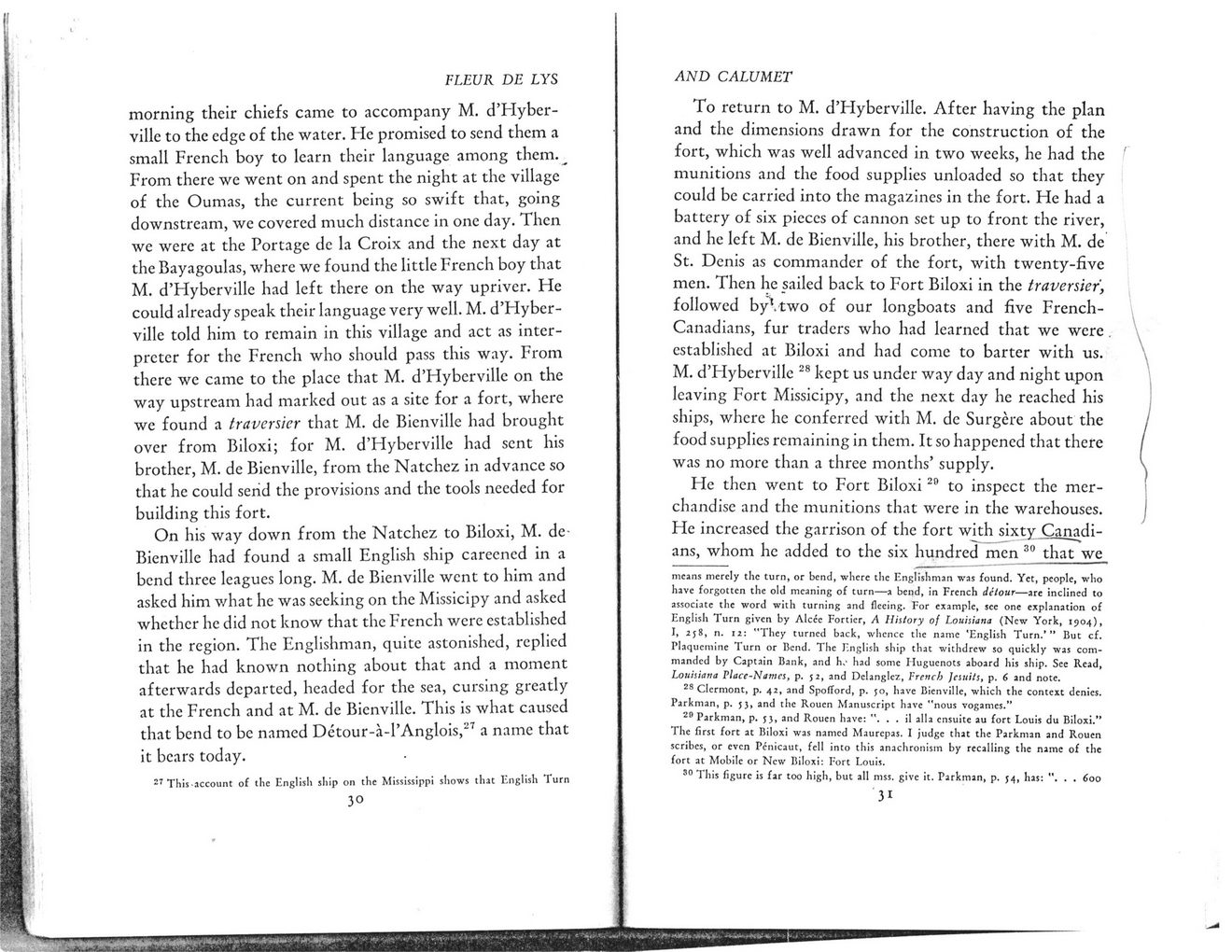This text was obtained via automated optical character recognition.
It has not been edited and may therefore contain several errors.
FLEUR DE LYS AND CALUMET morning their chiefs came to accompany M. d’Hyber-ville to the edge of the water. He promised to send them a small French boy to learn their language among them.^ From there we went on and spent the night at the village of the Oumas, the current being so swift that, going downstream, we covered much distance in one day. Then we were at the Portage de la Croix and the next day at the Bayagoulas, where we found the little French boy that M. d’Hyberville had left there on the way upriver. He could already speak their language very well. M. d’FIyber-ville told him to remain in this village and act as interpreter for the French who should pass this way. From there we came to the place that M. d’Hyberville on the way upstream had marked out as a site for a fort, where we found a traversier that M. de Bienville had brought over from Biloxi; for M. d’Hyberville had sent his brother, M. de Bienville, from the Natchez in advance so that he could send the provisions and the tools needed for building this fort. On his way down from the Natchez to Biloxi, M. de-Bienville had found a small English ship careened in a bend three leagues long. M. de Bienville went to him and asked him what he was seeking on the Missicipy and asked whether he did not know that the French were established in the region. The Englishman, quite astonished, replied that he had known nothing about that and a moment afterwards departed, headed for the sea, cursing greatly at the French and at M. de Bienville. This is what caused that bend to be named Detour-a-l’Anglois,27 a name that it bears today. 27 This account of the English ship on the Mississippi shows that English Turn 30 To return to M. d’PIyberville. After having the plan and the dimensions drawn for the construction of the fort, which was well advanced in two weeks, he had the munitions and the food supplies unloaded so that they could be carried into the magazines in the fort. He had a battery of six pieces of cannon set up to front the river, and he left M. de Bienville, his brother, there with M. de St. Denis as commander of the fort, with twenty-five men. Then he sailed back to Fort Biloxi in the traversier’, followed byVtwo of our longboats and five French-Canadians, fur traders who had learned that we were established at Biloxi and had come to barter with us. M. d’Hyberville 28 kept us under way day and night upon leaving Fort Missicipy, and the next day he reached his ships, where he conferred with M. de Surgere about the food supplies remaining in them. It so happened that there was no more than a three months’ supply. He then went to Fort Biloxi29 to inspect the merchandise and the munitions that were in the warehouses. He increased the garrison of the fort with sixty Canadians, whom he added to the six hundred men 30 that we means merely the turn, or bend, where the Englishman was found. Yet, people, who have forgotten the old meaning of turn—a bend, in French detour—are inclined to associate the word with turning and fleeing. For example, see one explanation of English Turn given by Alcee Fortier, A History of Louisiana (New York, 1904), I, 258, n. 12: "They turned back, whence the name 'English Turn.’ ” But cf. Plaquemine Turn or Bend. The English ship that withdrew so quickly was commanded by Captain Bank, and hv' had some Huguenots aboard his ship. See Read, Louisiana Place-Names, p. 52, and Delanglez, French Jesuits, p. 6 and note. 28 Clermont, p. 42, and SpofTord, p. 50, have Bienville, which the context denies. Parkman, p. 53, and the Rouen Manuscript have "nous vogames.” 20 Parkman, p. 53, and Rouen have: ". . . il alia ensuite au fort Louis du Biloxi.” The first fort at Biloxi was named Maurepas. I judge that the Parkman and Rouen scribes, or even Pcnicaut, fell into this anachronism by recalling the name of the fort at Mobile or New Biloxi: Fort Louis. 30 This figure is far too high, but all mss. give it. Parkman, p. 54, has: . . 600

Penicaut Narrative Document (021)